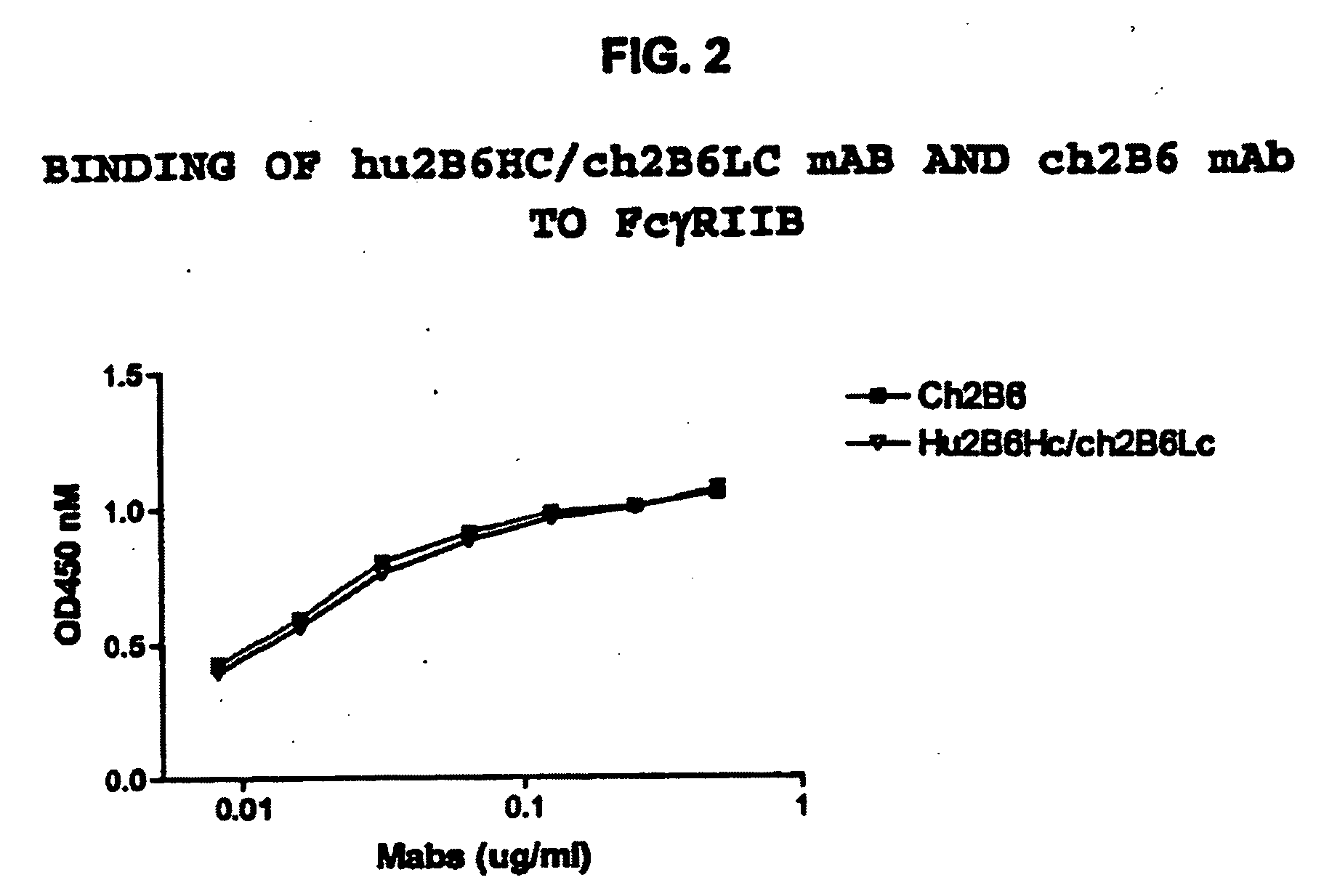FcGammaRIIB Specific Antibodies and Methods of Use Thereof
a specific antibody and fcgammariib technology, applied in the field of fcgammariib specific antibodies, can solve the problems of increasing the damage of the tumor, so as to enhance the effector function and enhance the therapeutic effect of current methods
- Summary
- Abstract
- Description
- Claims
- Application Information
AI Technical Summary
Benefits of technology
Problems solved by technology
Method used
Image
Examples
example 1
Humanization of Mouse Anti-Cd32b Mab 2b6
[0406]RNA was converted to cDNA and the VH and VL segments were PCR amplified using the RLM-RACE kit (Ambion, Inc.). Gene specific primers for the VH were SJ15R, SEQ ID NO:47 (5′ GGT CAC TGT CAC TGG CTC AGG G 3′) and SJ16R, SEQ ID NO:48 (5′ AGG CGG ATC CAG GGG CCA GTG GAT AGA C 3′). Gene specific primers for the VL were SJ17R, SEQ ID NO:49 (5′ GCA CAC GAC TGA GGC ACC TCC AGA TG 3′) and SJ18R, SEQ ID NO:50 (5′ CGG CGG ATC CGA TGG ATA CAG TTG GTG CAG CAT C 3′). The RACE product was inserted into the plasmid pCR2.1-TOPO using a TOPO TA Cloning kit (Invitrogen, Inc.). The resulting plasmids were then subjected to DNA sequencing to determine the VH and VL sequences for 2B6. The resulting sequences were then translated and the predicted amino acid sequence determined for each. From these sequences the framework (FR) and complementarity determining (CDR) regions were identified as defined by Kabat. The mouse VH was then joined to a human C-Gamma1 con...
example 2
Expression and Characterization of the Humanized 2B6 Heavy and Light Chains
[0409]The hu2B6 heavy chain (HC) expression plasmid was co-transfected together with ch2B6 light chain (LC) into HEK-293 cells. At the same time, the ch2B6HC was co-transfected with the ch2B6LC. After three days in culture the amount of human IgG expressed was quantitated by ELISA. Binding to dimeric soluble FcγRIIb-Fc was then determined by ELISA assay.
[0410]Protocol for ELISA assay: 2.5 ng / well of soluble FcγRIIb-Fc was captured on 96-well Maxisorp plates by mouse anti-FcγRIIb antibody 3H7 at room temperature for 1 hour. A serial of two-fold dilution of conditioned medium of ch2B6 or hu2B6Hc / Ch2B6Lc starting from 25 ng / well was added to the each well. The plate was incubated at room temperature for 1 hour, then binding was detected by HRP conjugated F(ab′)2 goat anti human IgG F(ab)′2 specific secondary antibody. After incubation with the secondary antibody for approximately 45 minutes, the plate was develo...
example 3
Generation, Expression and Binding of HU2B6LC Variants
[0416]There is a consensus sequence of N-glycosylation site (Asn-Xaa-Ser / Thr) in the Hu2B6LC CDR2 region (Asn50-Val-Ser). To eliminate the glycosylation at residue 50 and thus limit potential variation in production as well as potential immunogenicity in a pharmaceutical application, other amino acids were substituted at the position 50 using site-directed mutagenesis (Stratagene kit). Two different versions of Hu2B6LC were generated, Hu2B6LC-N50Y Hu2B6LC-N50Y,V51A. These amino acids were chosen because Tyrosine is the human acceptor residue at CDRL2 position 50 and Alanine is the residue at CDRL2 position 51 in the human germline gene segment.
[0417]Transfections of HEK-293 cells were performed using the following combinations: hu2B6HC / hu2B6LC; hu2B6HC / hu2B6LC(N50Y); hu2B6HC / hu2B6LC(N50Y,V51A); ch2B6HC / ch2B6LC. After three days in culture the amount of human IgG expressed was quantitated by an ELISA assay, using the method descri...
PUM
 Login to View More
Login to View More Abstract
Description
Claims
Application Information
 Login to View More
Login to View More - R&D
- Intellectual Property
- Life Sciences
- Materials
- Tech Scout
- Unparalleled Data Quality
- Higher Quality Content
- 60% Fewer Hallucinations
Browse by: Latest US Patents, China's latest patents, Technical Efficacy Thesaurus, Application Domain, Technology Topic, Popular Technical Reports.
© 2025 PatSnap. All rights reserved.Legal|Privacy policy|Modern Slavery Act Transparency Statement|Sitemap|About US| Contact US: help@patsnap.com



